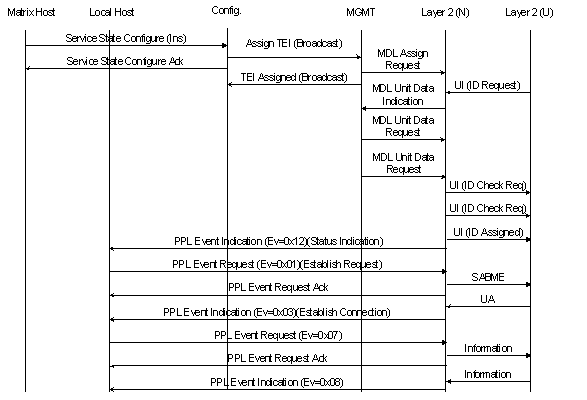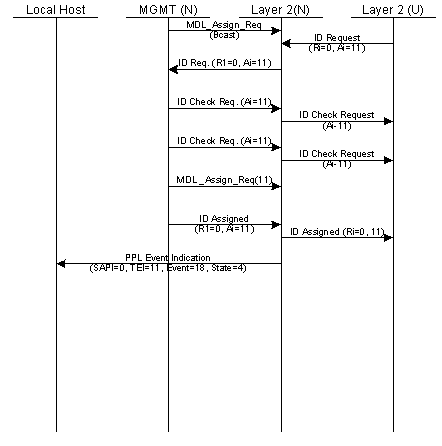
You are here: CSP Developer’s Guide: Common Channel Signaling > 8 ISDN > LAPD Inter-Module Configuration and Startup
LAPD Inter-Module Configuration and Startup

Overview
The figure on the next page represents host messaging when a network-side LAPD connection is brought up (already correctly configured) with GSM 8.56 TEIs. Upon receipt of the Service State Configure message, the Broadcast TEI is assigned. Management then waits for the ID request to be received from the user side.
After the software management (MGMT) system receives the ID request, the Transceiver (TRX) has the Action Indicator (AI) set to the TEI that it wants to establish (must be in the range 0-63). The network side sends an ID Check Request and waits for Timer 201 (T201) to expire. If T201 expires before it receives an ID Check Response, the network-side resends the Check Request and restarts T201. After this expiry, MGMT sends the ID Assigned, and updates its tables. When the TRX sends the ID Request, it starts T202, which is longer than T201. T202 expiration implies a failure, and the user terminal resends the ID Request.
After T202 attempts to get a TEI, the Layer 2 manager sends the host a PPL Event Indication message indicating an assignment failure.
Once the TEI assignment is successful, the host receives the PPL Event Indication message with status indication, Event=0x12, indicating that the DLCI state has changed to the TEI assigned state. The host must then issue the Establish Request PPL Event Request (Event=1) to bring up the data link. Once it is established, the PPL Event Indication message (Event=3) will be sent to the host indicating Establish Confirm. Upon reception of the Service State Configure message, the Broadcast TEI is assigned. Management then waits for the ID request to be received from the user side.
Network-side LAPD connection brought up with GSM 8.56 TEIs

The figure above shows the user-side requesting an ID with the non-standard Ri=0 and the AI=11 (11 was chosen at random for the example). MGMT receives this message and checks for TEIs configured for GSM 8.56. If the AI requested was configured by the host, then MGMT starts the check procedures (non-standard). When performing the checking procedures, it starts T201. In this case there are no other terminals with that TEI assigned, so there is no response. Upon T201 expiry, another ID Check Request message is sent, and if no response occurs, on that expiry the ID Assigned message is sent to the user. The result is that both Layer 2s for SAPI=0, and TEI=11 are in State 4 which is TEI-ASSIGNED. There is also a PPL Event Indication with the Status ICB with status value of 4 sent to the host.
When the user side sends the ID Request, T202 is started. In the above example, all of the messaging occurs prior to T202 expiring. When the ID Assigned message is received, T202 is stopped. Note that there are times when the Layer 2 Data Link Connection Identifier (DLCI) state machine can return to State 4 (TEI Assigned) and the host must issue another DL Establish Request to bring up the DLCI again.
Normal Startup Procedure
